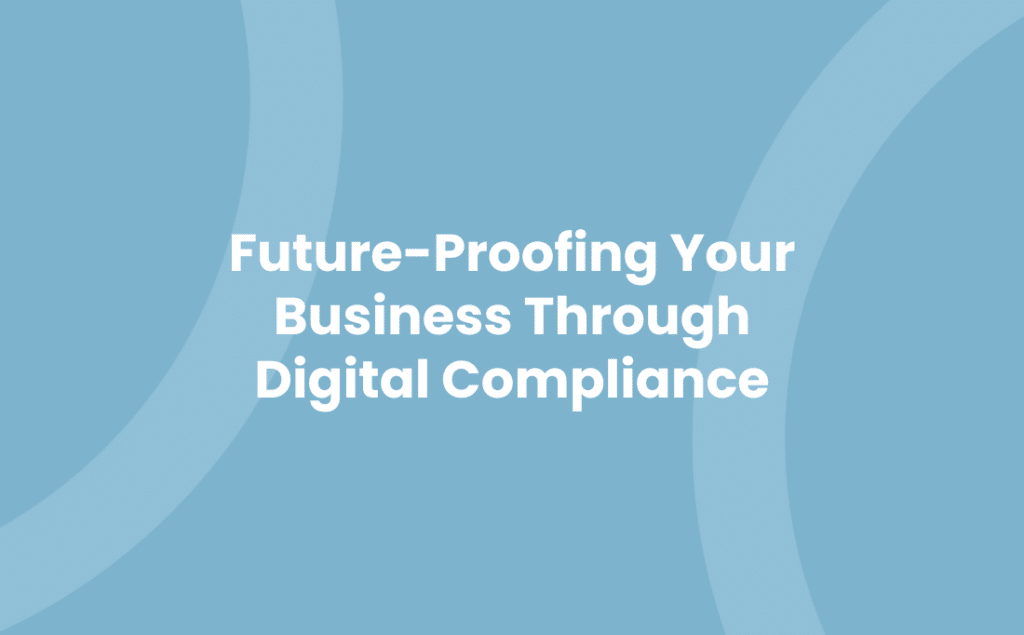In the digital age, it’s not enough to simply keep pace with technological advances; compliance with digital transformation is vital. But what exactly does this mean for you and your business?
Digital transformation compliance is all about ensuring that your business’s digital operations align with legal, ethical, and industry standards. It’s a dynamic process that requires constant attention and adaptation.
From data protection to accessibility, we’ll delve into the key aspects of digital transformation compliance, helping you navigate this complex landscape with confidence. Stay tuned as we unfold the intricate world of digital compliance, and help you turn it into a competitive advantage.
Understanding Digital Transformation Compliance
Digital Transformation Compliance forms an integral part of a business’s digital strategy. With a focus on adhering to regulations, it upholds the ethical and lawful conduct of operations in a digital realm. Without it, businesses risk damaging their reputation, facing hefty fines, or worse – falling prey to data breaches. Let’s delve into some key aspects of it, such as data protection and accessibility.
First, Data Protection commands a vital position in digital compliance. Digital Transformation Compliance points directly at maintaining the confidentiality and integrity of data—especially personal and sensitive ones—under all circumstances. For example, the General Data Protection Regulation (GDPR), imposed by the European Union (EU), mandates stringent rules for businesses concerning data collection, storage, and usage.
Next, Accessibility follows suit. For a business to be digitally compliant, its digital platforms must be accessible to all users, irrespective of their abilities. The British Standards Institute (BSI) outlines specific accessibility standards a business must meet, such as the Web Content Accessibility Guidelines (WCAG 2.1).
Digital Transformation Compliance isn’t a static standard, but a continuous journey. The digital landscape evolves consistently; this evolution impacts the regulations set forth, shifting them in sync. Therefore, compliance isn’t an end-goal, but an ongoing process of adaptation and improvement.
Indeed, navigating the route of Digital Transformation Compliance may seem daunting at first. But with a clear understanding of its elements and factors, your business can strive for better – by ensuring a fair, ethical, and law-abiding digital footprint. Remember, it’s not just about ticking a legal box; it’s enriching your brand’s reputation and gaining a competitive advantage in the digital marketplace. Your path to becoming a digitally compliant business starts here.
Primary Challenges in Achieving Digital Transformation Compliance
Crafting a successful digital compliance strategy innately poses several obstacles. While each company contends with distinct hurdles, universally certain challenges prevail.
Enhancing data protection requires mastery of digital compliance. Top-tier data protection shields against potential unauthorised access, securing confidential information, thereby safeguarding both businesses and clients against modern-day cyber threats. With a colossal increase in data breaches in recent years, companies find themselves in a persistent struggle to secure data. However, fear not! An integrated digital compliance strategy encompasses robust data protection measures in alignment with the likes of GDPR regulations.
Data access requirements can pose another stringent challenge, particularly in line with ever-evolving standards such as WCAG 2.1. To progress in the digital marketplace, businesses are integral to ensuring easy accessibility to services and information, breaking down digital barriers for all consumers. However, integrating accessibility features into digital products and services can seem a herculean task, demanding resource investment and expert beam guiding their track to digital transformation compliance.
Through the rapidly transforming digital viewpoint, compliance requirements constantly shift. Adapting to these changes, businesses face the task of keeping their digital operations and policies levelling with the current legal and ethical standards prevalent in the industry. Regulatory changes like Brexit also complicate matters, bringing about fresh legislation and requirements businesses must rapidly understand and apply within the digital framework. Regular compliance monitoring systems, therefore, prove crucial in navigating this challenge.
Moreover, businesses face the relentless task of continually enhancing their digital compliance strategy. Given its complex, ever-evolving nature, compliance isn’t a case of a hit and quits; it’s a progressive journey. This complexity frequently causes businesses underestimating the resources required, resulting in ineffective strategies that fail to meet compliance standards.
Rest assured, while these challenges might seem intimidating, armed with knowledge and a robust strategy, every business can surmount these hurdles and pave the way to successful digital transformation compliance.
How to Overcome Compliance Issues in Digital Transformation
Navigating the path of digital transformation compliance poses several challenges. Here’s a strategic approach to help you conquer these hurdles and align with digital compliance needs.
Draft a Concrete Plan
Planning provides the compass for any journey through digital transformation. In your plan, identify each step necessary for compliance and tie it to a specific goal. For instance, achieving GDPR compliance could be a primary objective.
Invest in Compliance Solutions
Investing in digital compliance platforms offers a proactive approach to meeting varying standards. Such platforms provide clear guidelines and insights into handling data, thus safeguarding against breaches.
Training ; Development
Your team is the ultimate force behind achieving digital compliance. Ensure that team members are trained up on current and emerging digital transformation compliance practices, making use of seminars, workshops, and online training resources.
Monitor ; Review
Maintaining compliance requires consistent monitoring and review of digital activities. Use compliance tools to track progress, and make necessary adjustments as circumstances change. This active engagement works to protect your business’ reputation and customer data integrity.
Partner with Professional Services
The assistance of external expertise can guide your journey to digital transformation compliance. Enlist the services of Consultants or Compliance Management firms to bolster your efforts for achieving and maintaining compliance.
The challenges of digital transformation compliance are manifold, yet they’re not insurmountable. This step-by-step approach provides the roadmap to help you conquer compliance obstacles, ensuring your business moves with precision and confidence in the digital landscape.
Case Studies of Successful Digital Transformation Compliance
Digital transformation compliance remains a pressing issue for multiple businesses across the UK. To better grasp the intersection of digital transformation and compliance, we may turn to real-world case studies. These instances highlight businesses that have effectively navigated the twin challenges of digitisation and compliance, laying the groundwork for successful transitions.
Deutsche Bank
One such instance is Deutsche Bank, a financial entity that saw effective digital compliance as instrumental to improving its infrastructure. In 2019, Deutsche Bank undertook a project to automate legal and regulatory activities. By incorporating advanced technologies, they managed to create an environment that allowed for data privacy, data governance, and GDPR alignment.
NHS Digital
A domestically relevant case study is NHS Digital, an executive branch of the UK National Health Service. They embraced a huge digital transformation project, ensuring WCAG 2.1 compliance every step of the way. This enabled NHS Digital to provide accessible content and services whilst fulfilling the stringent requirements of WCAG standard.
HSBC
Banking giant HSBC presents another example. Launching an ambitious digital transformation project, HSBC made sure that each part of their digital overhaul was compliant with the necessary regulations. Rigorous data protection measures marked their transformation process, demonstrating the powerful combination of digital modernisation and compliance.
By analysing these case studies, it becomes clear that future-focused planning, concern for data protection, accessibility considerations, and overall commitment to regulatory standards underpin the success of digital achievement. Each of the featured organisations embraced a proactive approach, integrating compliance into their digital transformation journey proactively, rather than treating it as a mere afterthought.
Take a page from these success stories. Intertwine compliance strategies with your digital transformation plans and let your business thrive in the expanding digital landscape. Remember, digital transformation isn’t an aimless journey – it’s a calculated move towards streamlined operations and matured tech capabilities. Compliance isn’t a burdensome obligation, but a beneficial inclusion for sustainable business growth.
Tools and Technologies for Ensuring Digital Transformation Compliance
Digging deeper into the tracks of digital compliance, it’s apparent that dedicated tools and technologies play a pivotal role. They’re the backbone of managing, monitoring, and maintaining compliance during digital transformation processes. Let’s explore some.
- Compliance Management Software: This software simplifies the compliance process by automating pieces of it, as in GDPR or WCAG 2.1 guidelines, making your life easier. Examples include LogicGate, Onspring, or MyEasyISO.
- Data Protection Tools: Businesses manage countless data points. To ensure their safety, data protection tools come into play. They secure sensitive data, reduce the risk of breaches, and maintain privacy regulations. Solutions like Vormetric, IBM Spectrum Protect, and Rubrik stand out.
- Cloud Services: Cloud platforms keep your data accessible and safe. They regularly update to stay aligned with regulatory guidelines and provide resources for digital transformation. Top choices are Microsoft Azure, Google Cloud, AWS, and IBM Cloud.
- Accessibility Tools: Accessibility is key in the digital era, and tools like Deque Systems and Tenon.io can help. They check whether your digital assets comply with WCAG 2.1 guidelines, smoothening your transformation journey.
- Cybersecurity Software: To combat the rising cyber threats, cybersecurity software is non-negotiable. They secure your digital platforms, handle vulnerabilities, and adhere to security compliance. Solutions like Norton, McAfee, and Avast lead the charge.
Remember, investing in the right tools is crucial for effective digital transformation compliance. So, delve into each one, assess your needs, and pick what suits you best. Armed with these tools, you’re ready to conquer the digital compliance landscape.
Note: Check the specifics of each tool thoroughly before picking one. Use trial periods where available, and most importantly, align them with your unique compliance strategy. It’s all about turning compliance into an advantageous part of your digital transformation.
Future of Digital Transformation Compliance
Look into the future of digital transformation compliance‚ it’s all about agility, flexibility, and foresight. Leap beyond current trends and embrace the evolving dynamics of the digital landscape.
Effective compliance management will represent a cornerstone of digital transformation trajectories. Today’s regulatory expectations observe a paradigm shift; they’re no longer static but continually evolving, driving firms to adjust their compliance strategies accordingly.
Privacy regulations are a primary concern‚ GDPR directives that focus on user data protection and privacy will continue exerting significant influence. Besides, emerging global regulations will necessitate bridging local and international compliance standards. For instance, the California Consumer Privacy Act (CCPA) introduces another layer of privacy rules that businesses must heed.
Moreover, rapidly evolving technologies like artificial intelligence (AI) and machine learning (ML) present a fresh compliance outlook. These technologies have the potential to change the way companies approach digital compliance, automating processes and efficient resource allocation. For instance, AI-based compliance tools can automate data management and risk assessment, reducing time and allowing teams to focus on strategic areas.
Cybersecurity will play an even larger role in future compliance. Rising cyber threats highlight the importance of maintaining robust, current security measures. Notably, compliance regulations reflecting this risk are becoming increasingly prevalent, such as the New York Department of Financial Services (NYDFS) Cybersecurity Regulations.
Investing in advanced technologies and robust cybersecurity measures is crucial. However, remember‚ the human element remains central. Employee education and training on compliance and cybersecurity present invaluable preventative strategies. Encouraging individual responsibility and digital hygiene instils a proactive compliance culture, preparing businesses for an agile digital future.
The future of digital transformation compliance looks challenging‚ it involves new regulations, evolving technologies, and looming cyber threats. However, businesses that proactively embrace these changes by investing in new technologies and promoting a culture of compliance are prepared to step into an exciting, digital era. Lessons from the past and current trends serve as valuable roadmaps‚ all that remains is for you to seize the opportunity and navigate the future of digital transformation compliance.
Conclusion
Navigating the digital transformation compliance landscape can be challenging, but it’s not an insurmountable task. You’ve seen how Deutsche Bank and NHS Digital have successfully integrated compliance into their operations. It’s clear that being proactive and investing in both advanced technologies and employee training are key to staying ahead. With evolving regulations and increasing cyber threats, your business needs to be agile, adapting to changes swiftly. Remember, compliance isn’t just about avoiding penalties; it’s about protecting your reputation and ensuring data security. As AI and ML continue to influence compliance processes, your approach should also evolve. Embrace the future of digital transformation compliance, and your business will be well-prepared for the digital age.


